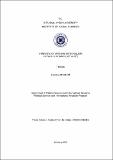DSpace Repository
A REVIEW OF AFGHAN NATIONALISM IN TWO CENTURIES (19th & 20th)
JavaScript is disabled for your browser. Some features of this site may not work without it.
| dc.contributor.author | RASHİDİ, Ziaulhaq
|
|
| dc.date.accessioned | 2021-06-15T11:26:41Z | |
| dc.date.available | 2021-06-15T11:26:41Z | |
| dc.date.issued | 2019 | |
| dc.identifier.uri | http://hdl.handle.net/11547/9021 | |
| dc.description.abstract | This thesis reviews the rise and growth of Afghan Nationalism in two centuries, the 19th century mainly the second half for the rise of Afghan nationalism and the 20th century for development of Afghan Nationalism. In this study, unlike the most of available works and researches, it has been tried to use reliable local narratives as source the most, in order to introduce Afghan nationalism from local (Afghan) perspective, rather than the international researchers’ angle. Moreover, the balance of perspectives and resources has been considered in the narratives from the both (Afghan and Pakistan) sides of the Durand Line with regards to the Afghan nation, nationalism and the role of Durand Line. This study has touched upon the cross-cutting points from the Afghan nationalism point of view in Afghanistan and Pashtun nationalism point of view in Pakistan. History texts, academic researches, studies and conferences reports in four languages, manly Afghani/Pashto, Persian/Dari, English and rarely Urdu language used as sources to make sure the study reflects balanced multilateral standpoints. While talking of Afghan nationalism, valid questions we may face, are: Firstly, what is the term Afghan and what is the history of Afghanistan? Secondly, when and how the Afghan Nationalism was established, which factors involved in its emergence and who were the key actors? Thirdly, why is the southern and eastern frontier with Pakistan named as the Durand Line and why the Afghan nationalists in Afghanistan and Pashtun nationalists in Pakistan concentrate on Durand Line as core? Before, these key questions are answered, we will try to look at the general overview of nationalism, the history of nationalism and its relation with globalization. This thesis provides a brief introduction of the general overview of nationalism, the major types of nationalism and the importance of nationalism in globalized era; and talks about the history and antiquity of the term Afghan; With the history of over 1700 years, how the term (Afghan) adopted as the national identity of all the citizens in course of centuries more particularly the last two centuries both in local and international narratives. The study requires to put some lights on the historical background of Afghanistan from a region located in the neighborhood of Khorasan and Turkistan regions to a country and then to an empire (Afghanistan empire/ Durani empire). Nation building efforts in Afghanistan and the construction of the foundation of Afghan nationalism a well as the rise of Afghan nationalism have been deliberated within second half of 19th century with more emphasis on the north-south resettlements programs along with major social and political reforms aimed modernization; the nationalistic struggles within secret groups hidden from the government eyes and then the new face of Afghan nationalism with full government support, role of media and modern educational institutions in early 20th century. ix The 2640 km long southern and eastern frontier of Afghanistan with Pakistan has not been recognized by the Afghan governments throughout the contemporary history as international border despite regime changes occurred with major ideological crack and variances. From the day the (Durand Agreement) signed (12 November 1893) till now, this frontier is named as Durand Line and challenged by Afghan states by Afghans/Pashtuns on the both sides of the line. We will look at the history of Pashtun nationalism and the effects of Durand Agreement (Durand Line) both on Afghan nationalism in Afghanistan and Pashtun nationalism in Pakistan in addition to the relations between these two nationalisms. Pashtun nationalism in Pakistan cannot be disconnected from Afghan nationalism, it can be defined vertically as subordination or at least horizontally side by side (Pashtun nationalism – Afghan nationalism) equally the two faces the same coin. Pashtun nationalists in Pakistan have been using Afghan identity the same as Pashton one. I will try to keep the balance of Pashtun nationalists’ viewpoints and Afghan nationalists’ viewpoints for balanced multilateral arguments. | tr_TR |
| dc.subject | Nationalism | tr_TR |
| dc.subject | Nation Building Efforts | tr_TR |
| dc.subject | Durand Line, Pashtunistan | tr_TR |
| dc.subject | Great Afghanistan | tr_TR |
| dc.title | A REVIEW OF AFGHAN NATIONALISM IN TWO CENTURIES (19th & 20th) | tr_TR |
| dc.type | Thesis | tr_TR |
Files in this item
This item appears in the following Collection(s)
-
Tezler -- Thesis [3470]
